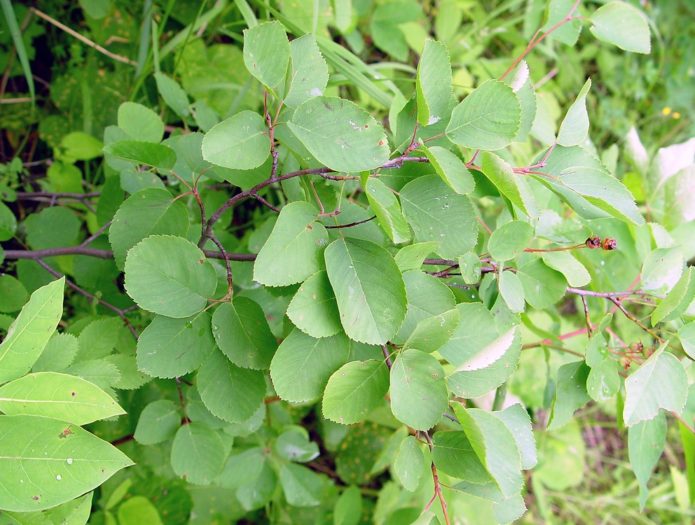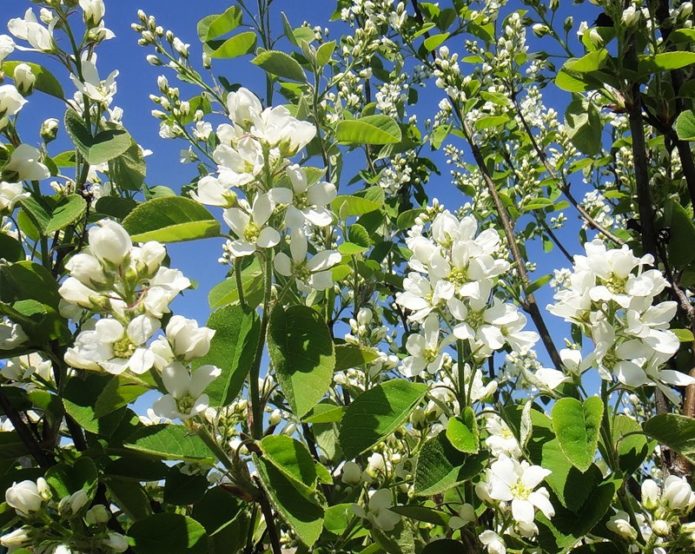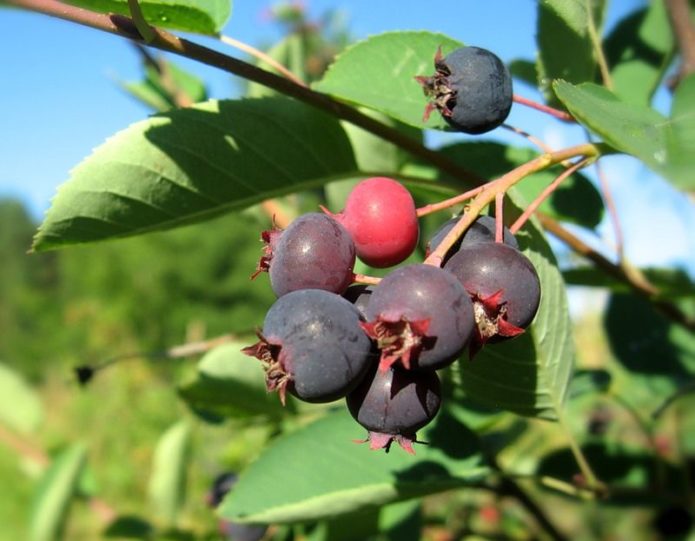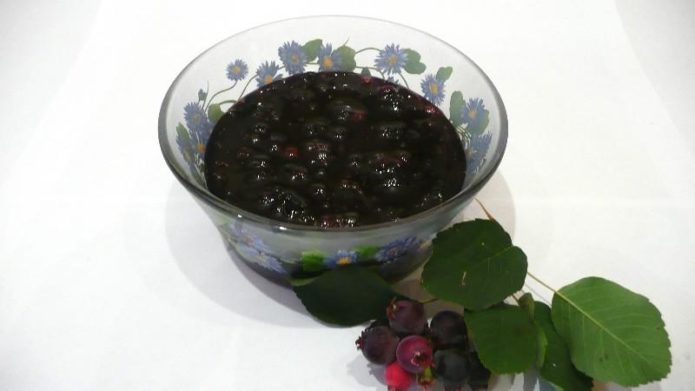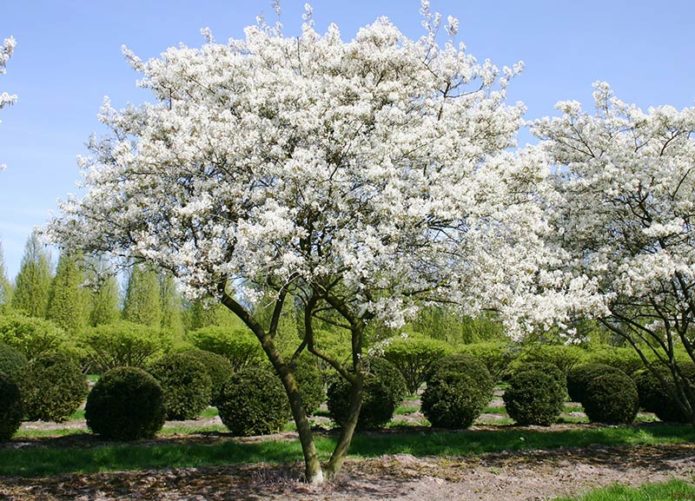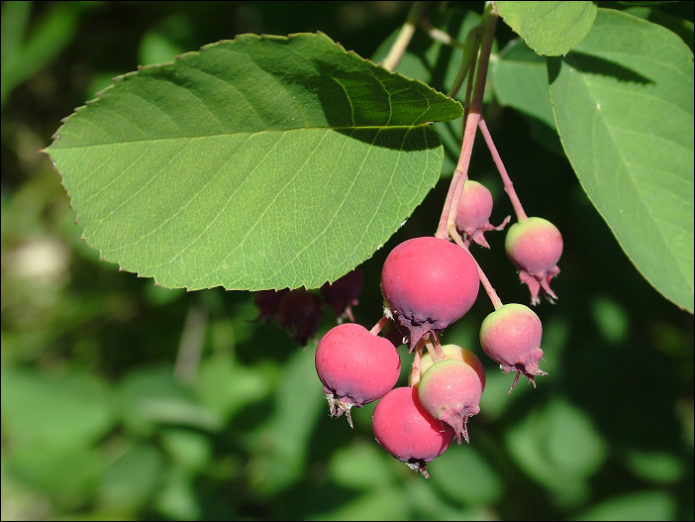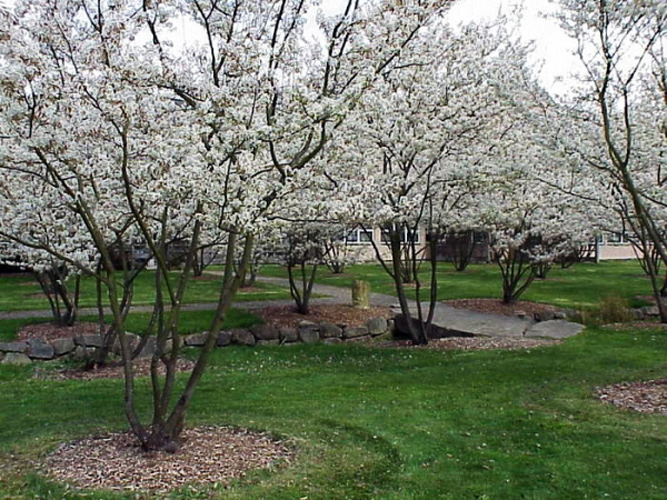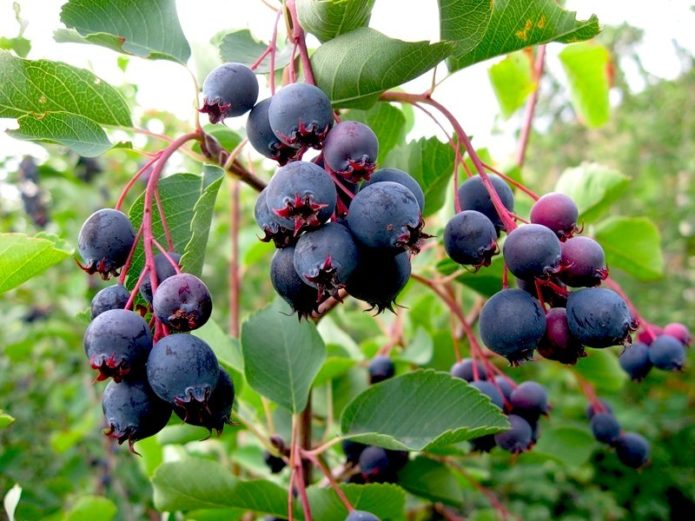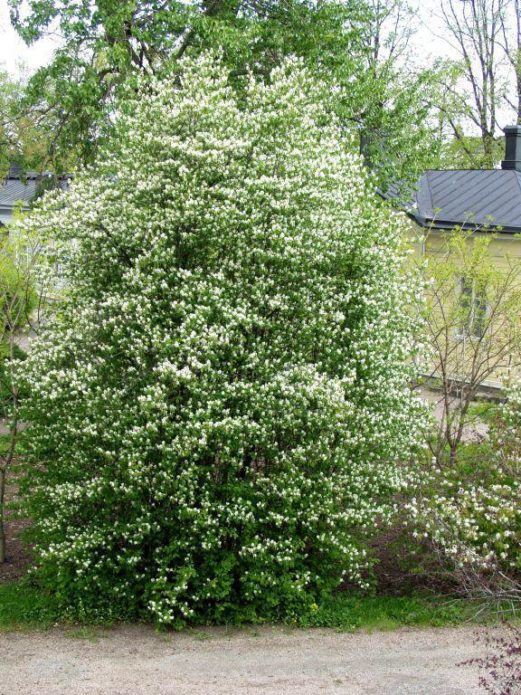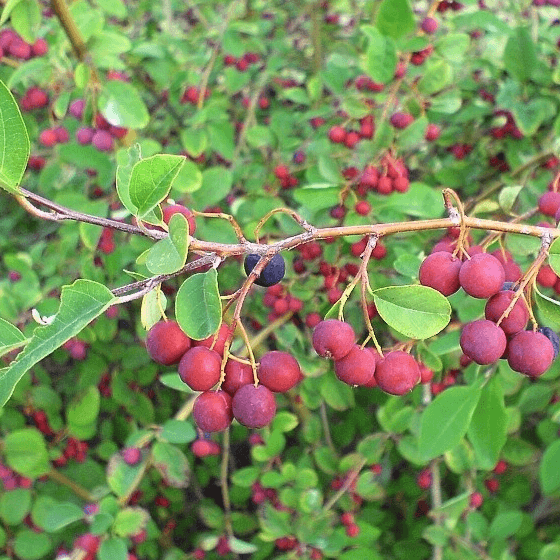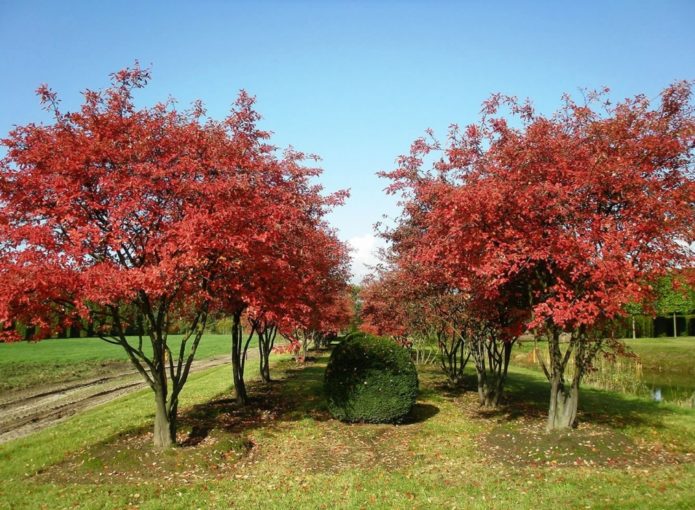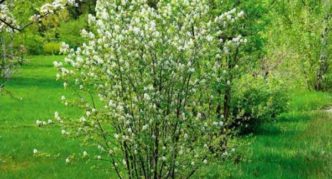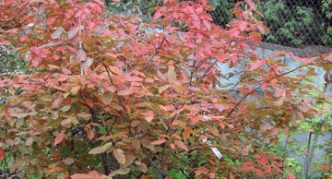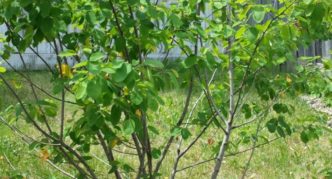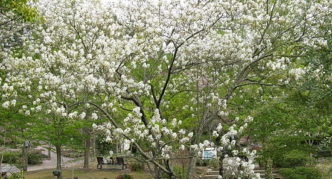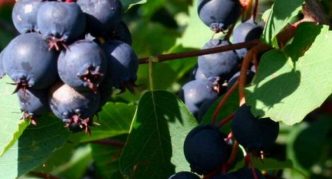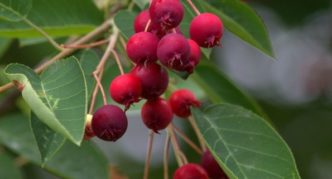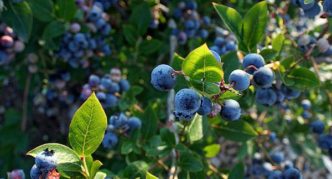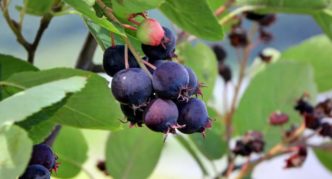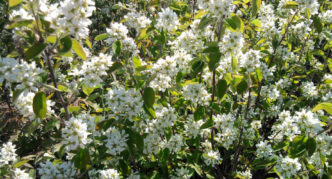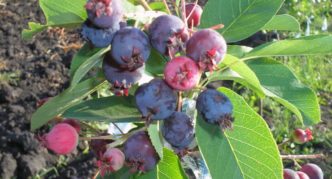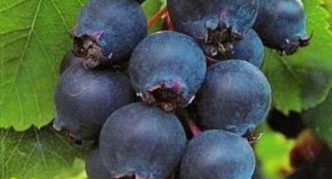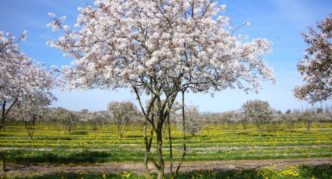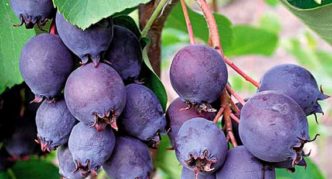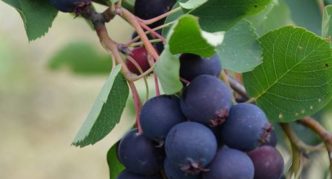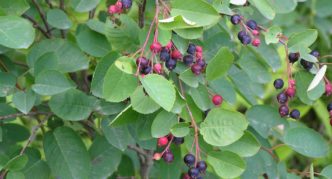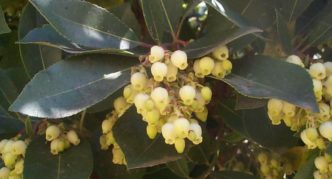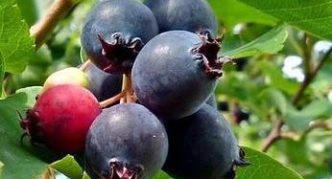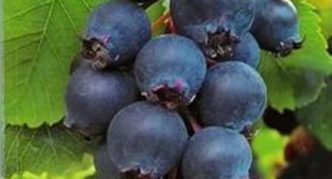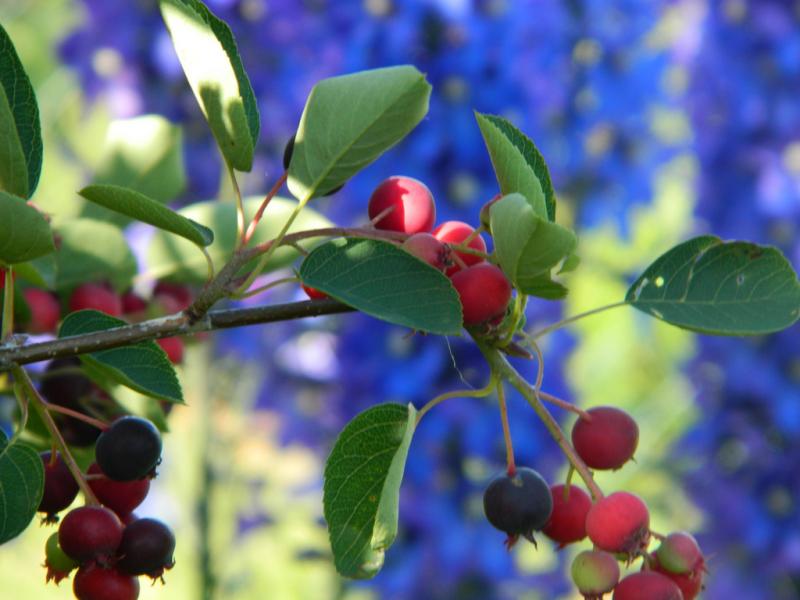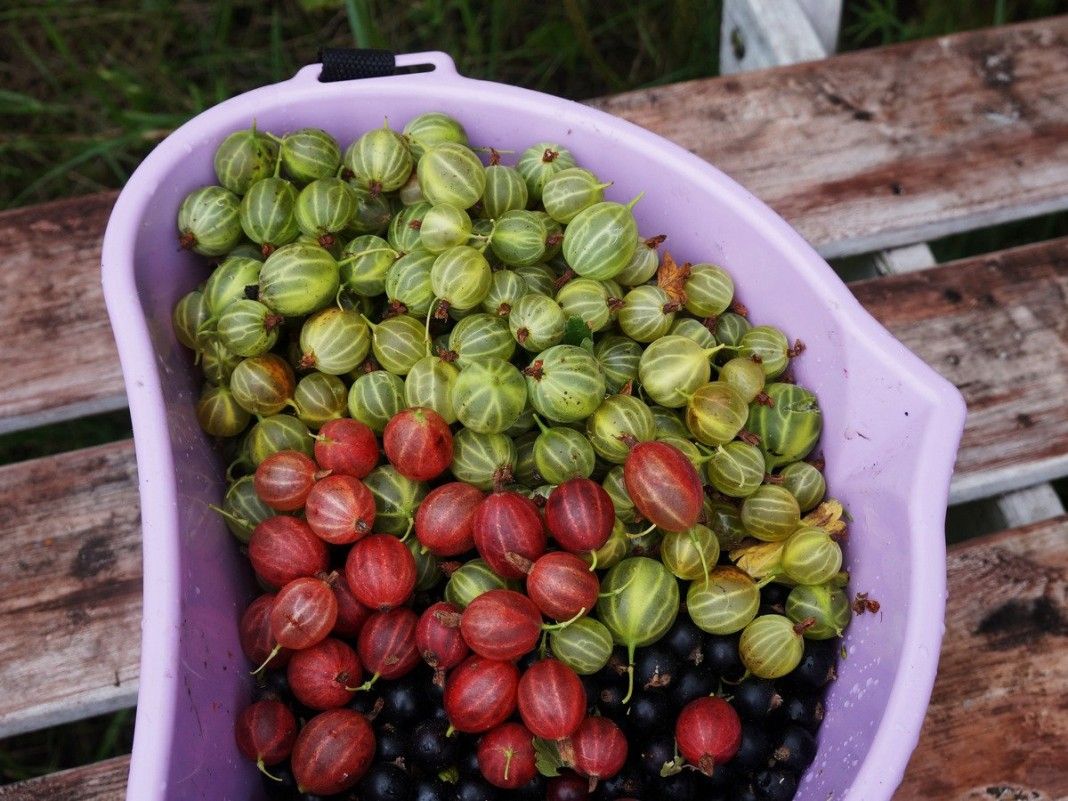Irga is an unpretentious ornamental plant that yields a harvest of healthy berries. She also has other advantages. However, in the garden plots of Russians, it is less common than one might expect. Often they try to grow exotic crops in the gardens, for which the Russian climate is completely unusual. Irga, on the other hand, tolerates severe winters remarkably. It is popular with breeders who are breeding new hybrids to improve performance, size and flavor.
Content
Description of irgi
Irga is a small genus of plants belonging to the Rosaceae family. Its rather close relatives are plum, pear and apple tree. You can't tell by the fruit, but during flowering the similarity is very noticeable.
According to various sources, there are from 20 to 25 varieties of irgi. In the northern hemisphere, it grows everywhere. In Russia, it is most common in the North Caucasus and Crimea.
Despite the fact that in terms of berries, irga is very similar to chokeberry, these are completely unrelated plants:https://flowers.bigbadmole.com/en/yagody/aroniya-chernoplodnaya-posadka-i-uhod.html
The culture successfully adapts even to unfavorable environmental conditions in large cities, therefore it is widely used for planting in parks, squares, when creating "green zones". The plant does not impose special requirements on the quality of the soil, without much damage to itself tolerates frost, including during winters with little snow, drought, heat.
In different countries, the plant is known by many nicknames. In Great Britain, irga is a "shadow", "healthy" or "June" berry. In the USA and Canada they use the name borrowed from the Aboriginal Indians - "Saskatoon". In the countries of the former USSR, it is called "wine" or "child" berry, as well as "cinnamon" (for the similarity of berries to small grapes). The very same word "irga", according to the most common version, comes from the Mongolian expression "very durable bush."
The average plant height is 3-5 m. But this parameter is easily regulated by competent pruning. But the irga is actively growing in breadth. Its root system is superficial, but extremely developed, root shoots are formed very abundantly. It is quite difficult to get rid of irgi in the garden, even if you specifically set yourself up for such a goal.
An adult plant, if not specially shaped, looks like a dense shrub, consisting of numerous trunks. The shoots of the irgi are quite thin. Young branches are pubescent, the bark is reddish. Leaves are relatively small, 8-10 cm long. They are located on long petioles. The edge is cut with small teeth. Freshly blossomed leaves are cast brownish or olive, then the shade changes to silvery-gray. Irga is distinguished by its growth rate; during the season, the branches can lengthen by 50–70 cm.
The productive life of a plant is at least half a century. With the help of a competent care for irga it can be extended for another 10–20 years. The plant bears fruit annually, starting at 5-6 years of age. On average, you can count on 15 kg of berries from an adult bush.
Blooming irga looks very impressive. The plant is literally covered with flowers with snow-white, cream or pastel pink petals, collected in small brushes. Flowering lasts about 1.5–2 weeks. Buds rarely suffer from recurrent spring frosts, withstanding temperatures as low as -7 ° C.
The plant looks no less pretty in the fall. Its bright green "fleecy" leaves on both sides are painted in various bright shades: lemon yellow, raspberry, crimson, red-orange, blood-scarlet, purple. They do not fall off for a long time, they stay on the plant almost until the beginning of winter.
Yergi harvest - round-shaped berries with a diameter of about 0.8 cm. Depending on the variety, they can be flattened or elongated. Unripe fruits are colored bright pink, which gradually changes to purple, inky purple and almost black. Ripening does not occur simultaneously, therefore, fruits of all possible shades can be observed on the branch at the same time. The skin of ripe berries is covered with a bluish-gray bloom. The crop is harvested early, fruiting begins at the end of June and lasts for several weeks.
The "natural" varieties of irgi have a sweet but fresh taste, so not everyone likes it. Most of the varieties and hybrids bred by breeding are distinguished by remarkable taste.
Application of berries
Irga is widely used in folk medicine. The pulp of berries contains vitamins C, K, P, PP in high concentration, as well as B vitamins, carotenoids, pectin, tannins. EThis determines the benefits of berries for strengthening immunity, treating anemia and vitamin deficiency, with problems with digestion, diseases of the heart and blood vessels.
Irgi juice is useful for any inflammatory processes, as well as skin diseases in the acute stage. It also helps with chronic stress, attacks of unreasonable anxiety, sleep disorders. But just squeezing it out of fresh berries will not work. They need to be allowed to lie down for several days in a dry place. To improve the taste, the prepared juice is mixed with apple or lemon.
Another record holder for the content of vitamin C in fruits is viburnum. What are its useful properties and are there any contraindications for use:https://flowers.bigbadmole.com/en/yagody/kalina-poleznyie-svoystva-i-protivopokazaniya.html
Other parts of the plant are also used. Flowers are used to prepare teas that normalize blood pressure and help cope with arrhythmias. Infusion and gruel from the leaves accelerate the healing of burns, wounds, abscesses and ulcers, normalize the microflora of the stomach and intestines, especially with frequent disorders. Infusion of the bark is recommended for angina, stomatitis, gastritis in the acute stage.
Irga is used not only in medicine, but also in cooking. Jam, jams, compotes are made from berries, jelly, marshmallows, and other desserts are prepared. It is often used in combination with apples, red or black currants, citruses to add a piquant sourness to a sweet, but bland taste. Irga is also popular with amateur winemakers.
Features of growing irgi
- Irgi berries are to the taste not only for people, but also for birds. It is to them that the plant owes much to the breadth of its habitat. The gardener should take this into account and prepare in advance for the attacks of birds. The only truly effective remedy is a strong fine-mesh mesh thrown over the bushes. Homemade or purchased "scarers" have an effect that lasts a maximum of 2-3 days.
- When choosing a place for irgi, it should be borne in mind that berry juice is a very high-quality dye. Therefore, you should not plant it next to a car parking place, a wall of a building painted in a light color, a path of white stones. Stains that form where berries fall are almost impossible to get rid of.
- Irga is self-fertile, that is, for regular fruiting, one bush on the site is enough. Nevertheless, practice shows that the presence of 2-3 varieties or hybrids has a positive effect on the yield, taste and size of berries.
- In European countries, the USA and Canada, irga is widely used in landscape design both in single plantings and in composition with other plants. The irgi hedge also looks very impressive.
- Irga is often used as a stock for apple and pear trees. Then it is very convenient to form the stanza. And the irgu itself, especially the scarce highly decorative varieties, are often grafted onto mountain ash.
Types of irgi
Most of the irgi species are very similar. Often only a professional botanist can distinguish them. In addition, plants easily interbreed with each other, forming interspecific hybrids.
Round-leaved
Irga round-leaved is also found under the names "Irga oval" and "Irga ordinary". This variety is widespread in Russia. Her homeland is the Crimea and the Caucasus, but with the help of birds carrying seeds, she even "reached" Western Siberia and successfully adapted there.
The plant reaches 2.5–3 m in height, bushy, with a wide spreading crown. Erect shoots, olive-gray bark. Egg-shaped leaves with a serrated edge. The average length of the leaves is 3.5–4 cm, width is about 2.5 cm. In autumn, they change color from dark green to scarlet or crimson, in the sun they shine golden.
Flowers 1.2–1.5 cm in diameter are collected in corymbose inflorescences of 6–12 pieces. When they fully open, the narrow long snow-white petals are strongly bent back, the bush looks like "fluffy". Flowering occurs in the first ten days of May, the beginning of fruiting - in mid-July (it often stretches until August). The first crop is harvested 5 years after planting in a permanent place. The productive period is about 40 years. The maximum possible yield is brought by a plant at the age of 10–20 years.
Fruit up to 0.8 cm in diameter (about the size of a pea) has an almost regular spherical or pear-shaped shape. The skin is purple-black with a bluish tinge. The pulp is raspberry, sweet, with a light honey-cinnamon flavor. The average weight of a berry is 0.3–0.4 g. Fruits are well stored without losing their beneficial qualities during freezing and heat treatment.
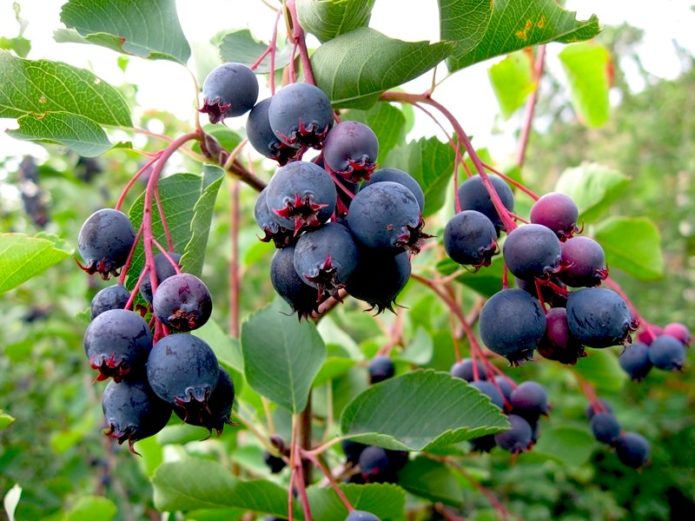
The fruits of the round-leaved irgi cannot boast of outstanding taste, but they are very useful and are stored for a long time
The plant is cold-resistant, it does not need special preparation for winter, successfully surviving frosts down to -40 ° C. Also, round-leaved irga does not suffer from recurrent spring frosts. It is undemanding to the quality of the soil, but prefers open, well-warmed areas by the sun. It multiplies easily, very actively forms basal shoots.
Irga round-leaved has good immunity, but if the summer is very damp and cold, gray rot may develop. Perhaps the gardener himself is to blame for this, too zealous with watering. To combat the disease, copper-containing preparations are used - fungicides.
Canadian
Irga canadian is the "parent" of most varieties and hybrids bred by breeding, the first variety of irgi, successfully domesticated by man in the 17th century. It is ubiquitous in northeastern North America. On other continents, it takes root with difficulty, with rare exceptions it can be found only in botanical gardens.
This is a shrub 5–6 m high or a tree that grows up to 8–10 m. In nature, there are also "champions" with a height of 15–18 m. Shoots are thin, flexible, drooping.They descend gradually, forming a wide crown, similar to a tent. The bark is reddish. The leaves are large, about 10 cm long. The reverse side is almost white due to the dense soft edge, similar to the pile. Up to 5 years, shoots grow quickly, then the rate gradually slows down.
Flowering is short-lived, lasts 1–1.5 weeks. The buds are collected in loose panicle inflorescences of 5-12 pieces. The petals are creamy or greenish. Flowering occurs in late April or early May.
The crop is harvested in the last decade of July. The berries are deep purple in color, they shine scarlet in the sun. The shape is round, slightly elongated. The pulp is juicy, sweet, bright pink in color. Low yield - 5–6 kg per adult tree.
The plant is very reluctant to propagate by seed. But the cuttings take root in almost 100% of cases. Irga canadensis is distinguished by cold and drought resistance, takes root even on saline and alkaline soils with a high lime content.
Irga canadensis is widely used in landscape design, in single plantings or for the formation of hedges. A flowering plant and bright autumn leaves, painted in all sorts of shades of orange, red, purple, look spectacular.
Spicate
The natural habitat of Spikelet Irga is the central part of the North American continent. It prefers to settle along the banks of rivers, successfully assimilates stony soils. It can be found on practically bare rocks and cliffs.
The plant is bushy, 4–5 m high. The crown is very thick and wide. Even without regular pruning, it takes on the correct oval shape. The bark on young shoots is brick-colored; this shade gradually changes to gray-brown.
The leaves are medium-sized, 4–5 cm long. From a distance, they seem whitish or silvery, since both sides of the leaf blade are densely pubescent. Short pedicels are also covered with the same soft "pile". In autumn, the bush resembles a fire, the leaves are painted in all sorts of tones of yellow and red-orange.
The flowers are very fragrant. The petals are white or pale pink. The buds are collected in dense brushes. Berries with a diameter of 0.9-1 cm ripen in the first decade of August. The almost black skin turns red in the sun. The pulp is sweetish, but the taste cannot be called outstanding. The first berries are removed 4 years after planting. The productive period is 30–35 years.
Irga spikelet is distinguished by its endurance and unpretentiousness even against the background of other varieties, it easily adapts to adverse environmental factors, and successfully reproduces in any way. It is also valued for its frost resistance down to -50 ° C and growth rate.

The fruits of the spicata are almost bland in taste, but for some reason birds are very fond of them
It is extremely rarely affected by diseases, but it can be attacked by leafworm caterpillars. The plant tolerates pruning without much damage to itself, the bush can be given any desired configuration.
The shrub is used as a rootstock and is planted in soils prone to erosion to strengthen them.
Irga Lamarca
Until recently, it was considered a natural mutation and a variety of canadian irgi, but modern botanists distinguish it as a separate species. It is the most decorative of the varieties of culture. Irgu Lamarck can be distinguished by its larger leaves and fruits, the abundance of flowering. Homeland - North America, but by the 19th century, the culture was widespread in northern Europe. It was mainly grown not for the sake of fruiting, but for landscaping public and private gardens. Looks especially good next to conifers. In Russia, Irga Lamarck is still relatively rare.
The average height of a shrub with a wide spreading crown is up to 5 m. Its diameter almost coincides with the height. For a year, the length of the shoots increases by 20–25 cm. As they mature, the lower part of the branches is gradually bare.
The leaves of the plant are 10–12 cm long, rather narrow (3–5 cm), with the edge cut out by the teeth. Freshly blossomed leaf plates are cast copper-red. They acquire the same shade in the fall.
Flowers 2–2.5 cm in diameter, with narrow snow-white or yellowish petals, odorless. The buds are collected in dense "panicles". The fruits are very sweet, juicy, the skin is blue-violet. They are filmed in the first half of August. Ripe berries do not crumble, they can hang on branches until frost.
Average yield is 6-7 kg per adult plant. You will have to fight with birds for berries. Robins, swifts, magpies are especially fond of Lamarck's irgu.
Frost resistance of the culture is about -35 ° C. It successfully takes root and bears fruit on almost any soil (with the exception of marshy). Irga Lamarca tolerates drought well, is extremely rarely affected by diseases and pests. The root system is very developed, the roots penetrate into the soil to a depth of 2.5–3 m.
Hawthorn is a common plant widely used in landscape design. It also has many health benefits, so gardeners who grow it in their backyards can kill two birds with one stone:https://flowers.bigbadmole.com/en/yagody/boyaryishnik-posadka-i-uhod.html
Other varieties
In addition to those described, there are other varieties of irgi, but they are very rare in gardens.
- irga low (pumila). A bushy, light-loving plant 1–1.2 m high. Prefers a light nutritious substrate. It is found mainly in North America, most often at the edges of deciduous forests. A shrub with many shoots and a very dense crown. The leaves are small, 2–2.5 cm long. The diameter of the flower with snow-white petals is 0.8–1 cm. The fruits are edible, the skin is black. The cuttings do not root very well;
- Irga smooth (laevis). Semi-shrub 3–3.5 m high. Habitat - northwestern part of North America. Frost resistance is very high, up to -45 ° C. Irga smooth was domesticated at the end of the 19th century, but did not become popular in Europe. Perhaps this is due to the difficulties with reproduction: the seeds do not differ in germination, the seedlings grow very slowly, the cuttings root poorly. The crown is spreading, rounded. The buds open before the leaves appear. The flowers are pastel pink, collected in long (8-10 cm) loose flowing brushes. Young leaves are also pinkish or reddish brown. Flowering lasts 15–20 days, sometimes more. Fruits with a diameter of about 0.5 cm, the skin is red-violet. The largest berries are located at the base of the brush;
- blooming irga (florida). Very similar to smooth irgu, but much more popular than it. In Russia, it is found mainly in the North-West region, common in Belarus. The average height of the tree is 4–6 m. The petals of the flowers are wider than those of the irgi, during flowering the tree seems to be covered with pinkish foam. It reproduces much easier. This applies to both the generative and vegetative modes;
- irga pleasant (amabilis). A bushy plant up to 2–2.5 m high. The crown is round, about 1.5 m in diameter. It differs from its “relatives” in that it tolerates shade well. Young seedlings grow rapidly. It blooms quite late, already in early summer. The harvest ripens en masse, in the second decade of August;
- Asian irga (asiatica). A powerful tree with a spreading crown, reaching 15 m in height. Found in Japan, Southeast Asia. It settles mainly on rocks. Does not bloom. Winter hardiness at the level of -20 ° C;
- irga blood-red (sanguinea). Shrub or semi-shrub 3–3.5 m high. The crown is spreading, its diameter almost coincides with the height. It blooms towards the end of May, the harvest ripens in mid-August. It does not breed very readily. Berries with dark scarlet skin are slightly flattened. Their taste is not very pleasant, there are a lot of seeds in a very dense, as if "rubber" pulp. Even birds do not eat these fruits. But they make a delicious juice, especially if you mix it with currant, apple.
Photo gallery: rare species of irgi
- Irga low bears fruit abundantly only if it receives enough sunlight and heat
- Irga smooth breeds not too willingly, therefore it is not popular with amateur gardeners
- Irga abundantly flowering fully justifies the name
- Irga pleasant - shade-tolerant, but not shade-loving plant
- Irgi asiatica has impressive dimensions
- Irga blood-red name owes to the shade of the skin of berries
Irgi varieties suitable for growing in different regions of Russia
The homeland of most varieties of irgi bred by breeding is Canada or the United States. But Russian specialists also have their own achievements. Since the climate in North America does not differ much from that which is typical for most of the territory of Russia, almost all varieties of foreign origin successfully take root and bear fruit in the Russian Federation.
Varieties for the Moscow region and the European part of Russia
When choosing irga for cultivation in the European part of Russia, you can give preference to one of the time-tested varieties popular in the USA and Canada.
- Smoky. At home, in Canada, it is one of the most popular varieties among farmers who grow irgu on an industrial scale. The berries are large, more than 1.5 cm in diameter. The bush is low, but spreading, with many shoots. It grows up to 2.5 m, the crown diameter is about the same. This greatly facilitates the care of the plants. The berries are widely used in home winemaking. Fruiting is annual. The only drawback is drought sensitivity. Blooming later;
- Martin. Thiessen variant. It is appreciated for its decorative effect and large fruit size. The harvest ripens en masse, the plant almost never suffers from diseases and is not attacked by pests. Fruits are spherical, 1.6–1.7 mm in diameter, with black-blue skin. They are collected in brushes of 16–20 pieces;
- Forestbourgh. Large-fruited variety, belongs to the category of late. Ripe berries have a black-violet skin, fruits are very sweet. It is distinguished by its drought resistance, it tolerates heat well. Berries with a diameter of 1.2–1.6 cm are collected in clusters of 7–13 pieces;
- Success. One of the few varieties bred on the basis of blood-red irgi. The fruits are large, up to 1.5 cm in diameter and 0.8–1 g in weight, with a dark scarlet skin. The taste is very balanced, sweet and sour, reminiscent of cherry;
- Pembina. A hybrid widespread not only at home, but throughout the world, bred on the basis of canadian irgi. The height of the bush is up to 3.5 m, the shape is almost a regular ball. The fruits are large, up to 2 cm in diameter, sweet and juicy. The variety belongs to the category of dessert;
- Pierson. Another Canadian variety. The bush is multi-stemmed, spreading, with abundant root growth. The fruits are almost spherical, with a diameter of more than 1.5 cm. The taste is excellent. The harvest ripens in the first decade of August;
- Prince William. Like all varieties bred on the basis of Lamarck's irgi, it is highly decorative and abundant in flowering. The height of the shrub is 3–3.5 m. The berries are dark purple in color. But the yield is low - 5–6 kg per bush. In autumn, the leaves take on a very beautiful red-orange hue. They do not fall off for a long time, until the first frost;
- Mandam. The plant looks like alder-leaved irgu, but the fruits are larger and more juicy. The average weight of a berry is 0.9–1 g. The growth rate does not differ, the fruiting period is greatly extended. The crown is elongated, similar to a column;
- Sleith. One of the earliest varieties. "Parent" - Irga Canadian. The bush is up to 1.5 m high. The leaves are very beautiful lettuce color, in autumn they are painted in all shades of red. The buds are collected in loose brushes. Snow-white petals are narrow and long, strongly bent back. The plant is light and thermophilic, frost resistance up to -25ºС. Birds are very fond of berries. Therefore, experienced gardeners recommend collecting them without waiting for full ripeness;
- Ballerina. It is planted mainly to decorate the site, although the fruits with black-red skin and an interesting almond flavor are juicy and sweet. Very high (up to 6 m) shrub. The shoots are thin, gradually drooping, hanging almost to the ground. Freshly blossomed leaves are cast bronze, in autumn they change color to crimson and purple. The flowering is very abundant.Snow-white flowers resemble stars, they are collected in loose racemose inflorescences. The variety is unpretentious, successfully adapts to the unfavorable environmental conditions in large cities.
Photo gallery: irgi varieties suitable for growing in the European part of Russia
- Irga Smoky is one of the most popular varieties among professional farmers
- Irga Martin is one of the most successful "clones" of the Thiessen variety
- Irga Forestbourgh is insensitive to prolonged droughts and extreme heat
- Irga Success is one of the few varieties bred with the participation of blood-red irga, inheriting from it the unusual color of the fruit
- Irga Pembina - one of the first achievements of Canadian breeders
- Irga Pierson forms very dense bushes
- Irga Prince William was bred on the basis of Irga Lamarck and inherited its decorative effect
- Irga Mandam is one of the novelties of foreign selection
- Irga Sleith is a variety belonging to the category of early
- Irga Ballerina is a tall, but at the same time very graceful plant
Varieties for the North-West region, the Urals and Siberia
The climate here is much more severe than in the European part of Russia, but the irga endures cold winters with little snow without much damage to itself. Even under these conditions, she does not need special shelter. At extremely low temperatures, the tips of the shoots can freeze, but the plant quickly recovers, this does not affect the yield in any way.
- Northline. The variety is bred on the basis of alder irriga. It is appreciated for its high yield and large fruit size. The height of the bush is about 1.5 m. The erect shoots gradually disappear. The bush consists of many trunks. The berries are collected in 12-15 pieces in dense clusters, from a distance they resemble small grapes. In shape, they can be both rounded and elongated. The harvest ripens in large quantities. The first fruits are tried 3-4 years after planting. Berries can be harvested mechanically;
- Thiessen. The tree is 4.5–6 m high. The variety belongs to the dessert category. The fruits are very juicy, fragrant, the pulp is sweet. Unlike other varieties, it does not actively form root shoots;
- Honeywood. One of the latest varieties, the harvest ripens at the end of August. The fruits are large, more than 1.5 cm in diameter. The skin is blue-violet, covered with a bluish waxy coating. The pulp with a light honey aroma, sugary-sweet, slightly tart. Berries, collected in a brush of 12-15 pieces, ripen in large quantities. The bush is low, up to 2.5 m, the root growth is not very active. The variety rarely suffers from diseases and pests. If it has enough moisture, the plant can do without fertilizing, bears fruit in almost any soil;
- Altaglow. A very showy plant with almost white berries. The tree is 6–8 m high, does not differ in growth rate. The crown is elongated, in the form of a pyramid. The leaves stay on the tree until the first frost, in the fall this is a real riot of colors - they are painted in a variety of shades of yellow, orange, scarlet, purple;
- Krasnoyarsk. Achievement of Russian breeders. The height of the tree is 3-4 m. The variety turned out to be high-yielding (12-15 kg of berries from an adult plant), extremely frost-resistant (up to -50 ° C) and large-fruited (berry diameter up to 1.8 cm). The harvest ripens in the last decade of July. The berries are almost regular rounded, the taste is sweet with a slight refreshing sourness;
- Starlight Night. One of the novelties of the Russian selection, bred on the basis of alder irgi. The variety was entered into the State Register of the Russian Federation in 2016. Shrub up to 3 m high, spreading. The fruits are easily identified by their very dark, almost black skin, dotted with small whitish dots. They appear when the crop is fully ripe. The average berry weight is about 2 g. Fruits are collected in a cluster of 10-15 pieces. Taste by professional tasters is rated at 4.7-4.8 points out of 5. The crop ripens massively or in two "waves".
Photo gallery: Irga grown in Siberia and the Urals
- Irga Northline is suitable for mechanized harvesting, the berries have a very dense skin
- Irga Thiessen - a variety that is valued for the taste of berries
- Irga Honeywood owes its name to an unusual honey flavor
- Irga Altaglow is easily identifiable during fruiting
- Irga Krasnoyarskaya is distinguished by a uniquely high frost resistance
- Irga Starry Night is one of the latest achievements of Russian breeders
Gardeners reviews
If we are to grow Lamarck's irgu, and I have one, it’s definitely not because of the priority of berries. The taste is specific, and not everyone likes it. Therefore, the issues of decorativeness and use in landscape design are more interesting in this case. For example, my pets don't even approach her. But the Smoky berry is called awesome.
I would not limit myself to dividing the irgi into "our", spiky (the least interesting, in my opinion, variety) and "Canadian", but still proceeded from the purpose of acquisition and planting, and as a result - varieties. If the interest is in the berry, then it is better to consider the varieties of alder-leaved irgi (shorter, larger and sweeter berries, but giving numerous shoots). The most interesting option might be the Canadian Smoky, which is one of the main varieties industrially grown for berries. If more decorative and berry option, then red-leaved (in the autumn) Irga Lamarca or the variety of Canadian Irga Prince William (let's say, medium-sized). Among the proposals of nurseries you can find varieties of another of the subspecies of irgi Autumn Brilliance, Forest Prince and Princess Diana (red-leaved, but even taller). Of the varietal offers of Russian origin, Irga Krasnoyarskaya "walks" on the market. There is also a novelty - the Mandam variety (the second is listed in the rather undersized). But I can't say anything about these varieties.
Yesterday I "studied" many varieties of irgi both on our websites and on Canadian and American ones. Canadians have created many varieties that grow both here and throughout the United States, but the climatic zones in the United States are different ... Here are two varieties of Irgi of Canadian selection that can be found in Ukraine, they suited me: Prince William and Sleith. The first berries are large up to 15 mm, ripening period is average, height up to 1.5 m. The crown is very decorative in autumn. Sleith variety: berries are large, oblong, pure sweet taste. Ripens early. Height from 1.5 to 2 m. But it still depends on the formation of the bush.
Irga, how I love her, so I grow many varieties, mostly Canadian, their fruits are collected in dense clusters, the berries are large and very sweet: Pembina, Sleith, Smoky, Prince William. Of our varieties, Irga Krasnoyarskaya grows, the berries are slightly less than those of Canadian varieties. My dacha is located in the forest, so we save the harvest of irgi, raspberries and yogurt by covering everything with a thin non-woven material.
The Canadian Irga was selected for short stature, this was one of the selection conditions. Therefore, most varieties are low. The Canadians themselves point to the possibility of planting Prince William and Princess Diana varieties in protective zones. Indeed, these varieties are the most vigorous for me. If I am not mistaken, Autumn Brilliance also has a high crown. Plant these varieties, and you will have a dense fence at least 6 m high. And the berry is large, especially in Autumn Brilliance. There is aesthetics and decorativeness from spring to autumn, in autumn the fence will burn with intense red foliage. The root offspring of the Irga is far from "bullet", although it can give, but stabbovye, they do not interfere, only increase the density of the fence. Irga is self-fertile and can bear fruit, even if there is one variety in the planting, that is, the yield will be.
Our irga has been growing and bearing fruit for 8 years. We like berries, we eat "live", as we have one plant, and I also cut it regularly to make it beautiful. The fruits are very fond of birds. Many people hide it from birds, because if you do not cover it, then nothing may remain until maturation.
Irga is a very cute, unpretentious, and most importantly, plant with very sweet and juicy berries. Growing fast enough. No shelter required for the winter. We also never performed any trimming. The only thing that the bush got was a couple of watering if the berries are poured in too dry weather. Well, a little rotted manure and / or ash in the spring.Propagated by layering. In theory, and cuttings, only last year I cut them late and nothing good came of the experiment. It is very good at the fence - both the hedge and it blooms beautifully, with berries it looks even more interesting. Again, what we don't eat ourselves is left to the birds.
Irga is not only an annual harvest of useful berries. The plant is widely used in landscape design. It looks impressive, while it does not require special care. Even a gardener who cannot boast of having a wealth of experience in the field of cultivating fruit trees and berry bushes is capable of growing irgi. The plant successfully adapts to almost any type of soil and bears fruit, almost not paying attention to the vagaries of the weather.

